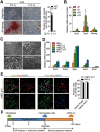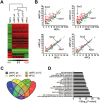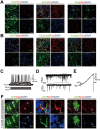Generation of neural progenitor cells by chemical cocktails and hypoxia
- PMID: 24638034
- PMCID: PMC4042166
- DOI: 10.1038/cr.2014.32
Generation of neural progenitor cells by chemical cocktails and hypoxia
Erratum in
-
Generation of neural progenitor cells by chemical cocktails and hypoxia.Cell Res. 2015 May;25(5):645-6. doi: 10.1038/cr.2015.55. Cell Res. 2015. PMID: 25941173 Free PMC article. No abstract available.
Abstract
Neural progenitor cells (NPCs) can be induced from somatic cells by defined factors. Here we report that NPCs can be generated from mouse embryonic fibroblasts by a chemical cocktail, namely VCR (V, VPA, an inhibitor of HDACs; C, CHIR99021, an inhibitor of GSK-3 kinases and R, Repsox, an inhibitor of TGF-β pathways), under a physiological hypoxic condition. These chemical-induced NPCs (ciNPCs) resemble mouse brain-derived NPCs regarding their proliferative and self-renewing abilities, gene expression profiles, and multipotency for different neuroectodermal lineages in vitro and in vivo. Further experiments reveal that alternative cocktails with inhibitors of histone deacetylation, glycogen synthase kinase, and TGF-β pathways show similar efficacies for ciNPC induction. Moreover, ciNPCs can also be induced from mouse tail-tip fibroblasts and human urinary cells with the same chemical cocktail VCR. Thus our study demonstrates that lineage-specific conversion of somatic cells to NPCs could be achieved by chemical cocktails without introducing exogenous factors.
Figures






Comment in
-
A chemical approach to "rewire" neural progenitor cells.Cell Res. 2014 Jun;24(6):641-2. doi: 10.1038/cr.2014.51. Epub 2014 Apr 18. Cell Res. 2014. PMID: 24743789 Free PMC article.
Similar articles
-
A chemical approach to "rewire" neural progenitor cells.Cell Res. 2014 Jun;24(6):641-2. doi: 10.1038/cr.2014.51. Epub 2014 Apr 18. Cell Res. 2014. PMID: 24743789 Free PMC article.
-
[VCR, a Small Molecule Compound, Induces Reprogramming of Rat Fibroblasts into Neural Progenitor Cells under Hypoxic Condition].Sichuan Da Xue Xue Bao Yi Xue Ban. 2022 Sep;53(5):790-797. doi: 10.12182/20220960501. Sichuan Da Xue Xue Bao Yi Xue Ban. 2022. PMID: 36224680 Free PMC article. Chinese.
-
Direct Conversion of Mouse Fibroblasts into Neural Stem Cells by Chemical Cocktail Requires Stepwise Activation of Growth Factors and Nup210.Cell Rep. 2018 Jul 31;24(5):1355-1362.e3. doi: 10.1016/j.celrep.2018.06.116. Cell Rep. 2018. PMID: 30067988
-
Inhibition of glycogen synthase kinase 3 increased subventricular zone stem cells proliferation.Biomed Pharmacother. 2017 Sep;93:1074-1082. doi: 10.1016/j.biopha.2017.07.043. Epub 2017 Jul 18. Biomed Pharmacother. 2017. PMID: 28738501
-
Advances in Small Molecules in Cellular Reprogramming: Effects, Structures, and Mechanisms.Curr Stem Cell Res Ther. 2021;16(2):115-132. doi: 10.2174/1574888X15666200621172042. Curr Stem Cell Res Ther. 2021. PMID: 32564763 Review.
Cited by
-
Chemical transdifferentiation: closer to regenerative medicine.Front Med. 2016 Jun;10(2):152-65. doi: 10.1007/s11684-016-0445-z. Epub 2016 May 3. Front Med. 2016. PMID: 27142989 Review.
-
Conversion of Human Fibroblasts into Induced Neural Stem Cells by Small Molecules.Int J Mol Sci. 2022 Feb 3;23(3):1740. doi: 10.3390/ijms23031740. Int J Mol Sci. 2022. PMID: 35163660 Free PMC article.
-
Transplantation of Chemical Compound-Induced Cells from Human Fibroblasts Improves Locomotor Recovery in a Spinal Cord Injury Rat Model.Int J Mol Sci. 2023 Sep 8;24(18):13853. doi: 10.3390/ijms241813853. Int J Mol Sci. 2023. PMID: 37762156 Free PMC article.
-
Efficient Generation of Chemically Induced Mesenchymal Stem Cells from Human Dermal Fibroblasts.Sci Rep. 2017 Mar 17;7:44534. doi: 10.1038/srep44534. Sci Rep. 2017. PMID: 28303927 Free PMC article.
-
Cell-based regenerative and rejuvenation strategies for treating neurodegenerative diseases.Stem Cell Res Ther. 2025 Apr 6;16(1):167. doi: 10.1186/s13287-025-04285-7. Stem Cell Res Ther. 2025. PMID: 40189500 Free PMC article. Review.
References
-
- Gilbert S.Developmental Biology6th Edition: Sunderland: Sinauer Associates 2000.
-
- Gurdon JB, Elsdale TR, Fischberg M. Sexually mature individuals of Xenopus laevis from the transplantation of single somatic nuclei. Nature. 1958;182:64–65. - PubMed
-
- Campbell KH, McWhir J, Ritchie WA, Wilmut I. Sheep cloned by nuclear transfer from a cultured cell line. Nature. 1996;380:64–66. - PubMed
-
- Miller RA, Ruddle FH. Pluripotent teratocarcinoma-thymus somatic cell hybrids. Cell. 1976;9:45–55. - PubMed
-
- Blau HM, Chiu CP, Webster C. Cytoplasmic activation of human nuclear genes in stable heterocaryons. Cell. 1983;32:1171–1180. - PubMed
Publication types
MeSH terms
Substances
LinkOut - more resources
Full Text Sources
Other Literature Sources
Molecular Biology Databases

